ChatGPT gets around 2.5 billion prompts daily. Is your brand mentioned in one of those prompts? That is the ultimate question.
The truth is, there is no way to tell what people are typing in ChatGPT exactly. Unlike Google search, where you can use SEO tools like Ahrefs and Surfer SEO to know the keywords that people use to search, ChatGPT doesn’t provide data on what people type.
The good news is that many GEO (generative engine optimization) tools will help you get some data to understand how your brand is doing.
This guide shows you:
- How to see brand mentions in ChatGPT
- What those mentions mean for your business
- What actions to take based on what you discover
What is Considered a Brand Mention in ChatGPT?
Before you start tracking, you need to understand what actually counts as a brand mention in ChatGPT. Not all mentions are created equal, and knowing the difference helps you prioritize your optimization efforts.
Brand Mentions as Part of the Answers
The most common type of mention occurs when ChatGPT directly includes your brand in its response text. This looks like conversational recommendations where your company name appears naturally in the AI’s answer.For example, if someone asks, “What’s the best ChatGPT mention tracker?” and ChatGPT responds with a list of recommendations, including your brand name.
Here you can see Genrank is mentioned:
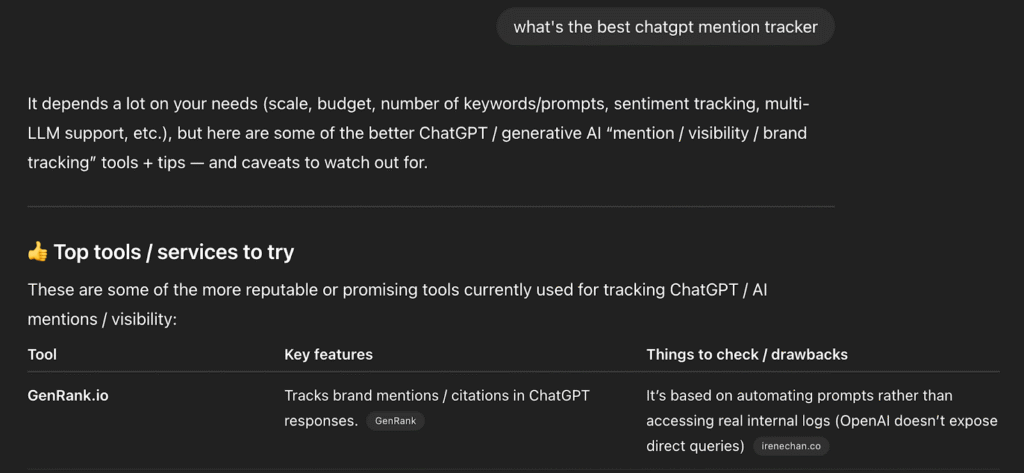
That’s a direct brand mention.
Citations and Source Links
The second type of mention is more formal. Citations with actual links to your website or content.
When ChatGPT uses web search functionality (available to Plus and Enterprise users), it can pull current information from the web and cite specific sources. Your brand might appear as a clickable citation linking directly to your website, blog post, or resource.
Here’s a list of shampoo bar alternatives I was searching for on ChatGPT:
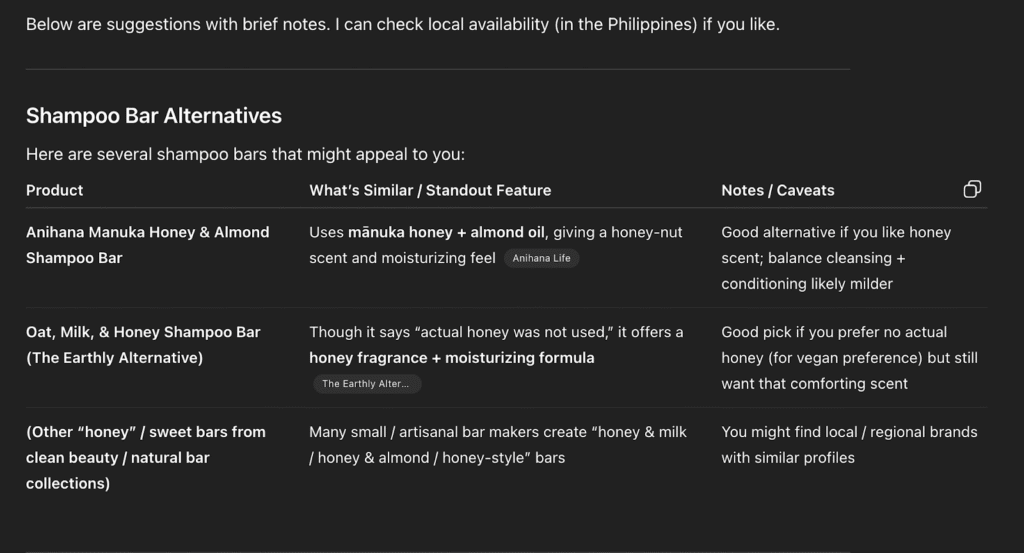
Citations typically appear as numbered references within the response or as source links at the bottom of ChatGPT’s answer. This is similar to how academic papers cite sources, except you’re being referenced in a conversation with millions of potential customers.
Pro tip: To make things easier, use Genrank to track how your brand is mentioned in ChatGPT. It’s free up to 10 prompts.
How to Search for Brand Mentions in ChatGPT (Manual Method)
If you’re just starting to explore your AI visibility, manual searching gives you immediate insights without investing in tools. While it’s time-consuming, this method helps you understand what’s happening right now.
What Questions Do People Ask About Your Brand?
Start by thinking like your customers. What would someone type into ChatGPT if they were looking for solutions in your space?
Create a list of prompts that potential customers might actually use:
- “What are the best [your category] for [specific use case]?”
- “How does [Your Brand] compare to [Competitor]?”
- “Is [Your Brand] worth the investment?”
- “What are alternatives to [Your Brand]?”
- “Who are the top companies in [your industry]?”
Testing these prompts manually gives you a reality check. You’ll quickly discover whether ChatGPT knows about your brand at all, and how it talks about you when asked directly.
Not sure what kind of questions people ask? Here are some ideas where to pull the questions from:
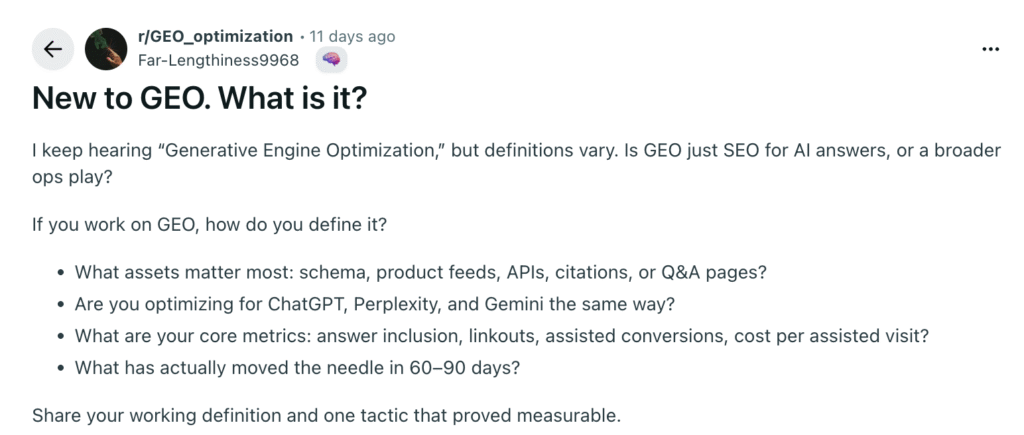
- Reddit: Check subreddits and see what kind of questions people ask about your brand or industry.
- Support: Collaborate with your Support team and ask them the list of questions they usually receive that aren’t covered in the knowledge base.
- Competitors: Go to your competitor’s site and identify their FAQs to give you a few ideas.
Important note: Note that ChatGPT’s responses will not always be the same, and there are potential combinations of responses. Ask different people in different locations to see what the responses are when you type in the same questions.
What Questions Do People Ask About Your Industry?
Broaden your search beyond direct brand queries. What are people asking about your industry, products, or services in general?
This matters because most ChatGPT users aren’t searching for specific brands. They’re asking open-ended questions like:
- “How do I choose the right [product category]?”
- “What should I look for when buying [your product type]?”
- “What’s the difference between [solution A] and [solution B]?”
- “Who are the influencers in [your industry]?”
Test these industry-level prompts and see if your brand appears. If you’re showing up in these broader conversations, you’re capturing people in the awareness and consideration stages, not just the decision stage.
This is where you want to be mentioned. When someone’s still exploring options and learning about solutions, appearing in ChatGPT’s response puts you on their consideration list.
Manual search can be tedious, but it’s the fastest and cheapest way to see if your brand is getting mentioned on ChatGPT.
For example, when I did a manual search for my brand name, I discovered old articles about me. Some of them are even using my maiden name! I have been writing about SEO for the past 15 years, and I have too much online data that no longer reflects my current roles and projects.
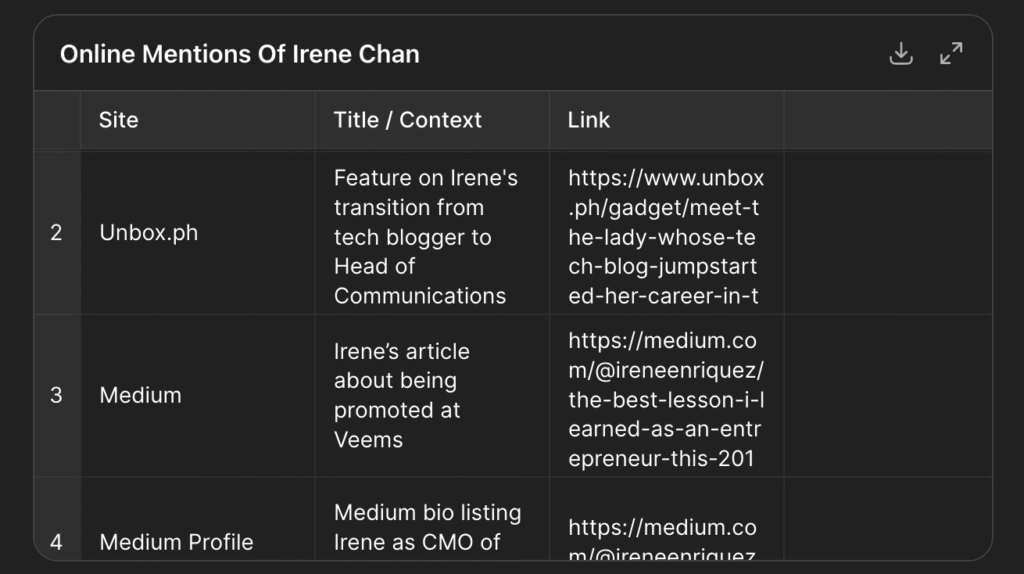
If you want to do a full GEO audit (and not just track brand mentions in ChatGPT, read our full GEO audit checklist.
How to Use a GEO Tool to Track Brand Mentions in ChatGPT
Manual searching tells you what’s happening right now. But what about yesterday? Last week? How do you track changes over time or monitor dozens of relevant prompts?
This is where GEO tools become essential.
Pick a GEO Tool
GenRank specializes exclusively in ChatGPT tracking, making it the most focused solution for monitoring your brand mentions on the platform.

Here’s what makes GenRank different from trying to track manually:
- Prompt monitoring: Add the specific prompts you care about, and GenRank fetches fresh ChatGPT responses on your chosen schedule. You’re not manually typing queries every day.
- Brand mention detection: The platform analyzes each response and highlights exactly where your brand appears (or doesn’t appear). You can see your mention frequency, positioning, and context at a glance.
- Web search tracking: Since ChatGPT can pull from current web content, GenRank tracks both training data mentions and real-time web search results.
The setup process is straightforward. You add your brand, create a list of relevant prompts that matter to your business, and GenRank handles the rest. The free plan lets you track 10 prompts without a credit card, which is enough to get started and understand your current visibility.
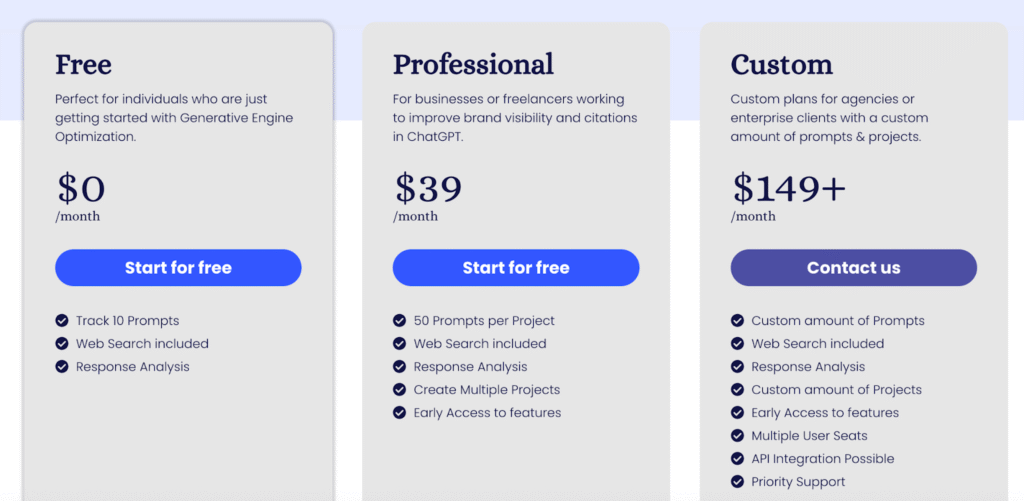
For a complete comparison of available tools, check out this breakdown of top GEO tools for monitoring your brand on AI platforms.
What to Do with Data About Your Brand in ChatGPT
Tracking mentions is pointless if you don’t act on what you discover. The data tells you where you stand and what needs to change. Here are some suggestions on what to do based on your findings.
If your brand has zero mentions…
If ChatGPT isn’t mentioning your brand at all, you have work to do. This isn’t a reflection on your product quality. It’s a signal that your content and online presence aren’t optimized for AI discovery.
It’s also possible that the prompts you’ve tracked aren’t exactly relevant, or there aren’t many people actually typing them.
Also, if you have a smaller or newer site, it’s very likely that you won’t get any citations at the time you are tracking ChatGPT mentions.
But all is not lost.
Here’s your action plan:
- Audit your online presence: Is your brand information consistent across your website, LinkedIn, industry directories, and review platforms? Inconsistent or incomplete information makes it harder for AI to understand who you are and what you do.
- Create comprehensive content: Develop thorough guides, case studies, and resources that establish your expertise. AI tools favor sources that cover topics in depth rather than surface-level blog posts.
- Implement structured data: Add schema markup to your website so AI crawlers can easily understand your organization, products, and content. This is fundamental technical work that improves both traditional SEO and GEO.
- Build authority signals: Get mentioned in industry publications, contribute to relevant forums and communities, and encourage detailed customer reviews. AI tools build their understanding of your brand from multiple sources across the web.
This isn’t a quick fix. Building AI visibility takes consistent effort over months. But the sooner you start, the sooner you’ll appear in those crucial recommendation moments.
Your brand has mentions, but they are outdated…
Maybe ChatGPT is mentioning your brand, but the information is wrong, outdated, or irrelevant. This happens when AI tools have incomplete or old training data about your company.
Your action plan:
- Update your core content: Refresh your website’s about page, product descriptions, and key resources with current, accurate information. Make sure your value proposition and key benefits are crystal clear.
- Create recent, authoritative content: Publish new case studies, research, and thought leadership that reflect your current offerings and expertise. Fresh content signals to AI tools that you’re active and relevant.
- Fix misinformation proactively: If ChatGPT is citing outdated information, create new content that corrects it. For example, if your pricing model changed but old information persists, publish a detailed pricing guide that AI can reference.
- Monitor and refine: Use your GEO tool to track how mentions change as you update your content. You should see improvements over weeks and months as newer information gets incorporated into AI responses.
Earlier, I mentioned that some of the sites are still using my maiden name or linking to an offer that doesn’t exist anymore. I went back to sites that I can edit right away, like Gumroad. I linked to my new site instead of an old domain that no longer works.
Keep Producing Relevant Content
If you’re already getting quality mentions, congratulations! But don’t stop now.
Your ongoing action plan:
- Maintain content freshness: Regularly update your pillar content with new data, examples, and insights. AI tools favor recently updated sources over static content.
- Expand topic coverage: Identify gaps where competitors are getting mentioned but you’re not. Create comprehensive content in those areas to capture more mention opportunities.
- Build thought leadership: Publish original research, industry surveys, or unique perspectives that only your brand can provide. This creates citation-worthy content that AI tools love to reference.
- Track performance consistently: Run your key prompts weekly or monthly through your GEO tool. Watch for changes in mention frequency, positioning, and competitor dynamics. Adjust your content strategy based on what you learn.
Don’t stop your SEO efforts, as it actually helps a lot in getting you mentioned in LLMs. Update your SEO strategy with GEO in mind and keep providing valuable content to your readers and customers.
Start Tracking Your ChatGPT Visibility Today
The brands dominating ChatGPT mentions didn’t get there by accident. They started tracking, learned what worked, and adjusted their content strategy accordingly.
You now know exactly how to see your brand mentions in ChatGPT, what those mentions mean, and what to do about them. The question is: will you act on it?
Start with the manual method if you want quick insights. Or jump straight into a GEO tool like GenRank to track consistently over time. Either way, don’t wait until your competitors have already claimed the top mention spots in your industry.
The sooner you understand your AI visibility, the faster you can optimize for it.
FAQs about Brand Mentions in ChatGPT
How do you list your products or services in ChatGPT?
You can’t directly submit your products to ChatGPT like you would to Google Merchant Center. ChatGPT learns about your business through its training data and web search functionality. To increase visibility, create content that your potential customers might ask about in ChatGPT.
How do you get your brand mentioned by ChatGPT?
Getting mentioned requires building a comprehensive online authority. Focus on creating in-depth, authoritative content that thoroughly covers your industry topics. Implement proper schema markups and get mentioned in other sites that are important to your industry.
How to show up in ChatGPT results?
Start with technical foundations by allowing AI crawlers in your robots.txt file and implementing structured data markup. Create comprehensive, well-structured content that directly answers common questions in your industry.
What tools can I use to track brand mentions in ChatGPT?
GEO tools like Genrank can help you specifically track brand mentions in ChatGPT. It monitors your chosen prompts and if your website is cited in one of the answers. There are plenty of GEO tools, and it depends on what you want to monitor and which LLMs.
